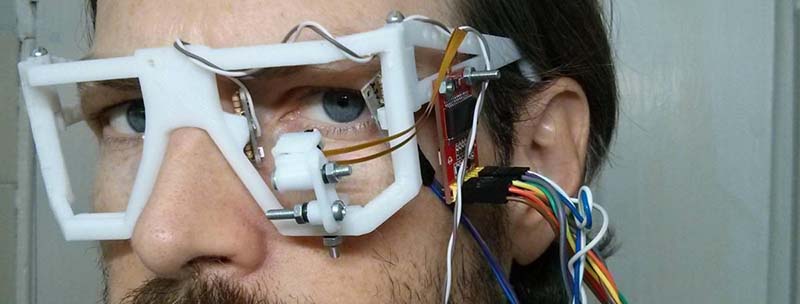There’s a lot of tech that goes into animatronics, cosplay, and costumes. For their Hackaday Prize entry, [Dasaki] and [Dylan] are taking the eyes in a costume or Halloween prop to the next level with animatronic eyes that look where the wearer of this crazy confabulation is looking. It’s XEyes in real life, and it promises to be a part of some very, very cool costumes.
The mechanics of this system are actually pretty simple — it’s just a few servos joined together to make a pair of robotic eyes move up and down, and left to right. This entire mechanism is mounted on a frame, to which is attached a very small camera pointed directly at the user’s (real) eye. The software is where things get fun. That’s a basic eye-tracking setup, with IR light illuminating the pupil, and a compute unit that can calculate where the user is looking.
For the software, [Dasaki] and [Dylan] have collected a bunch of links, but right now the best solutions are the OpenMV and the Eye of Horus project from last year’s Hackaday Prize. It’s a great project, and a really fun entry for the Automation portion of this year’s Hackaday Prize.



















I predict that we’ll be seeing a huge increase in zombie fashion.
Isn’t there a way to track eyes by placing electrodes on the skin and treating the eyeball as a resistor or capacitor? I’m not sure it’d be better or cheaper than the IR camera approach, but it might be worth looking into (unintentional pun).
Just do it the other way round: Contract the eye muscles with a small current, so that the human eye position the Costume.
I wonder how Canon did it with their ECF back in the 90s https://en.wikipedia.org/wiki/Canon_EOS#Eye-controlled_focusing
My guess? Mostly Analog. You’re in very close, and by using an IR sensor, the existing optics, and a couple of strategically placed PIN diodes, you should be able to triangulate the iris.
Why control just eyes? Why not control a pair of cameras, that way you can record everything you look at exactly like you look at it.
Hopefully the spinoff of this will be simple/cheap eye tracking that has a lot of other uses in everything from adaptive devices for the handicapped to, well, aiming stuff. The one suggestion I’d have from looking at this is that [Dylan] might want to root around his hardware store for nylon nuts and bolts since they’d cut a lot of weight from the eyepieces he’s testing.